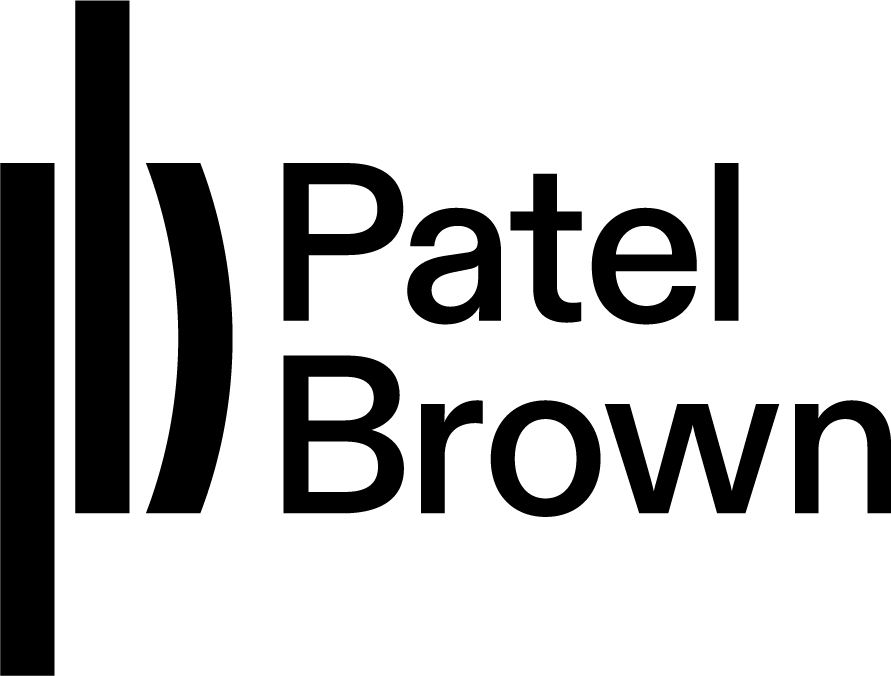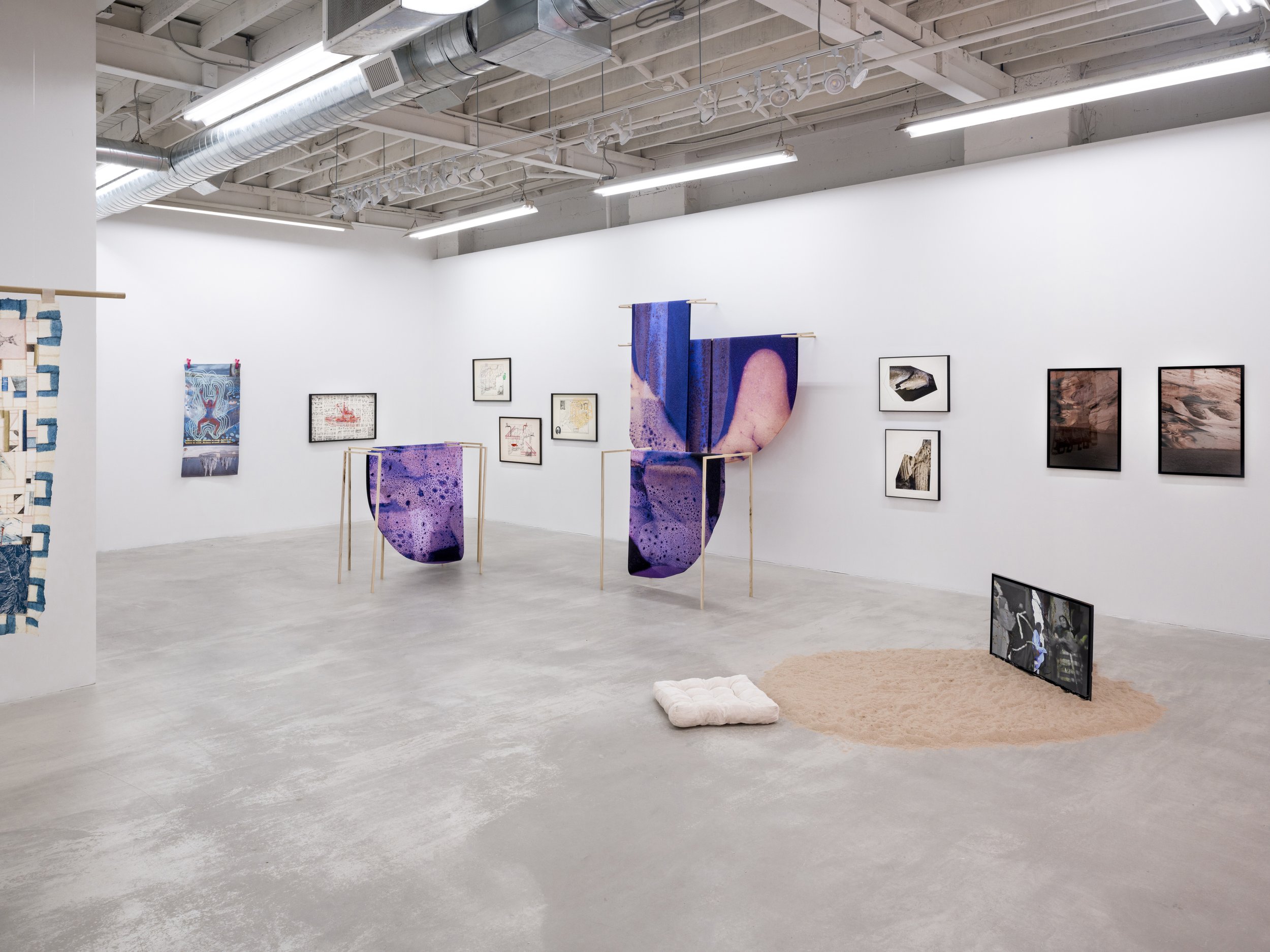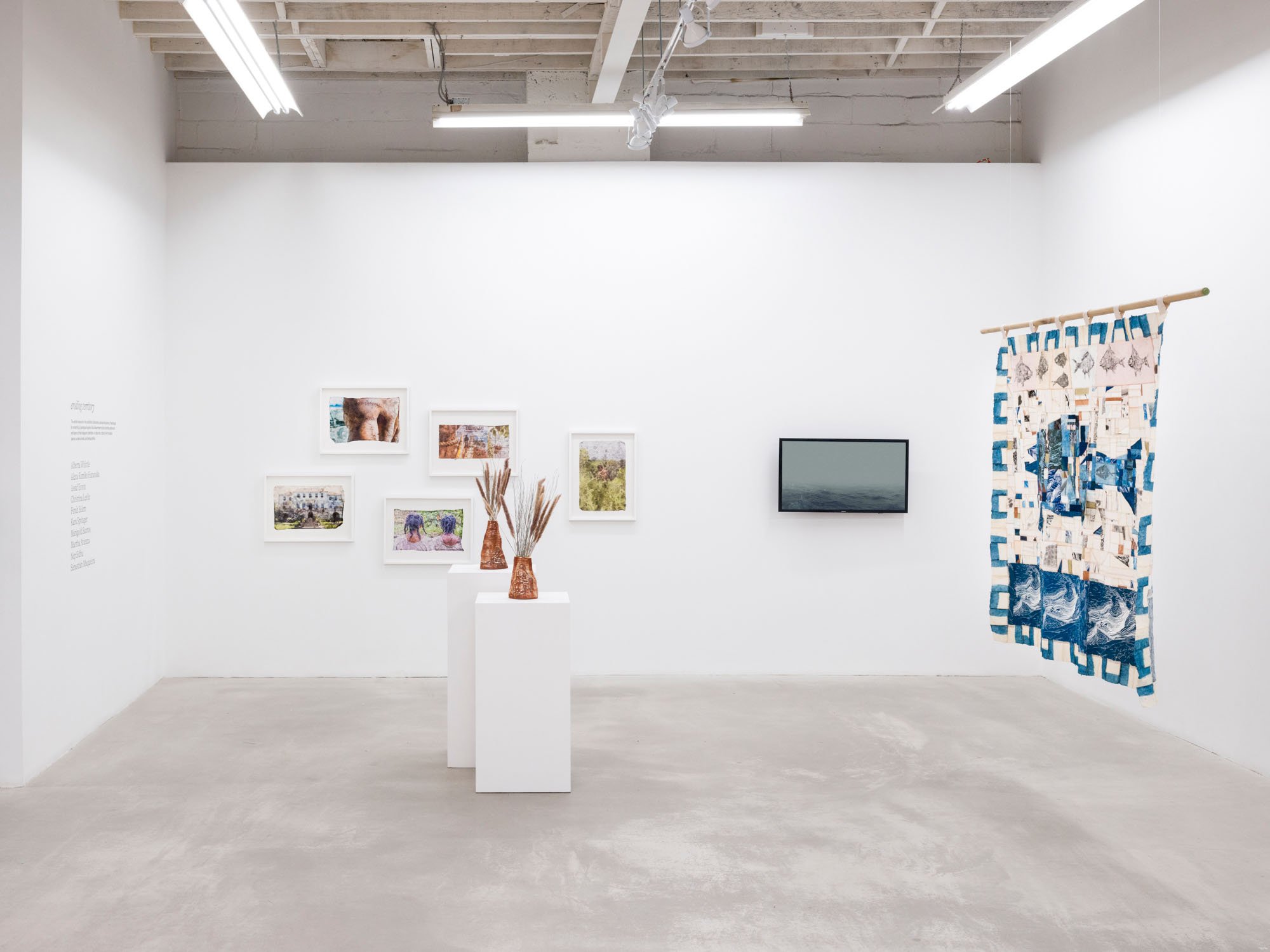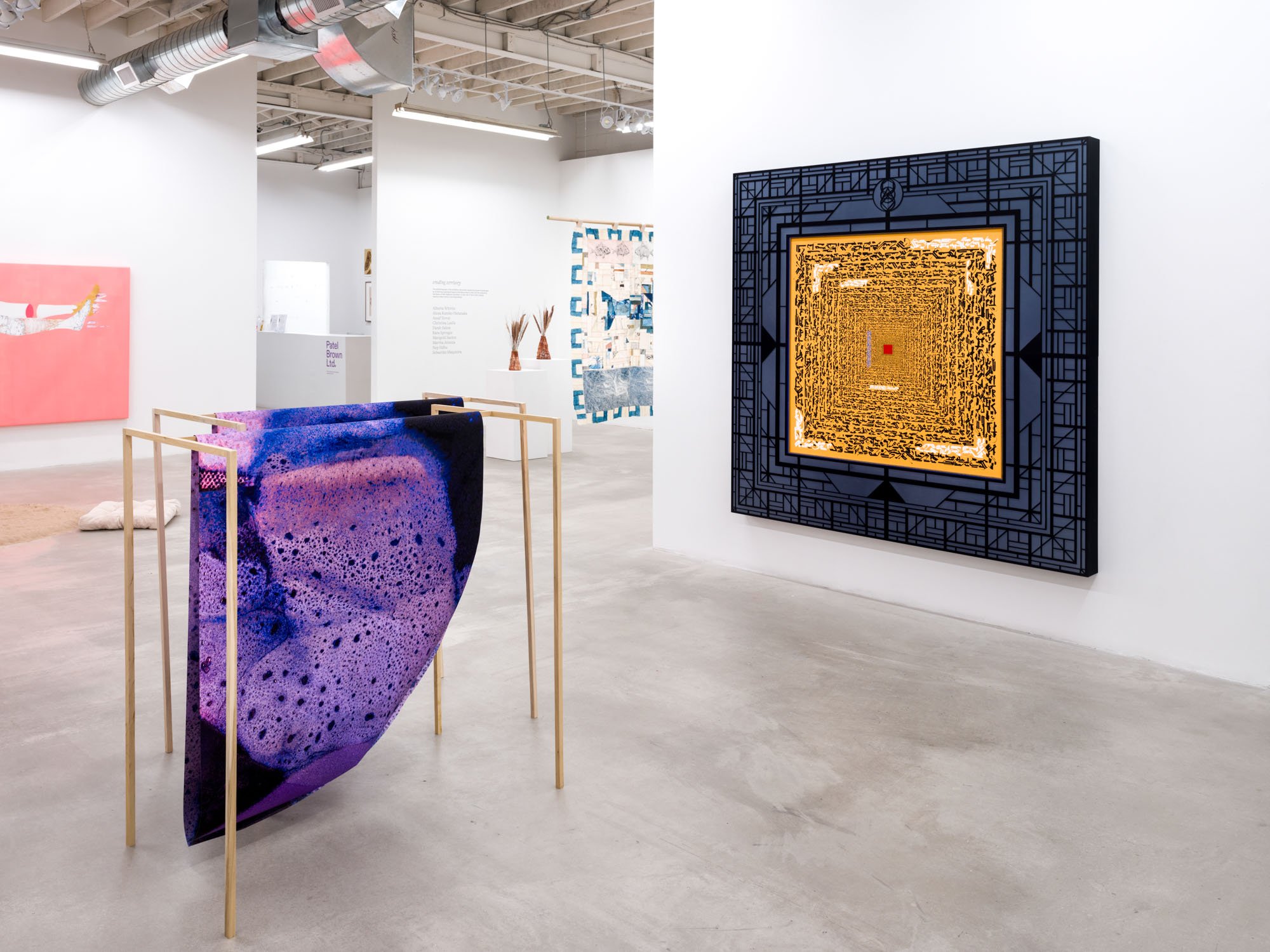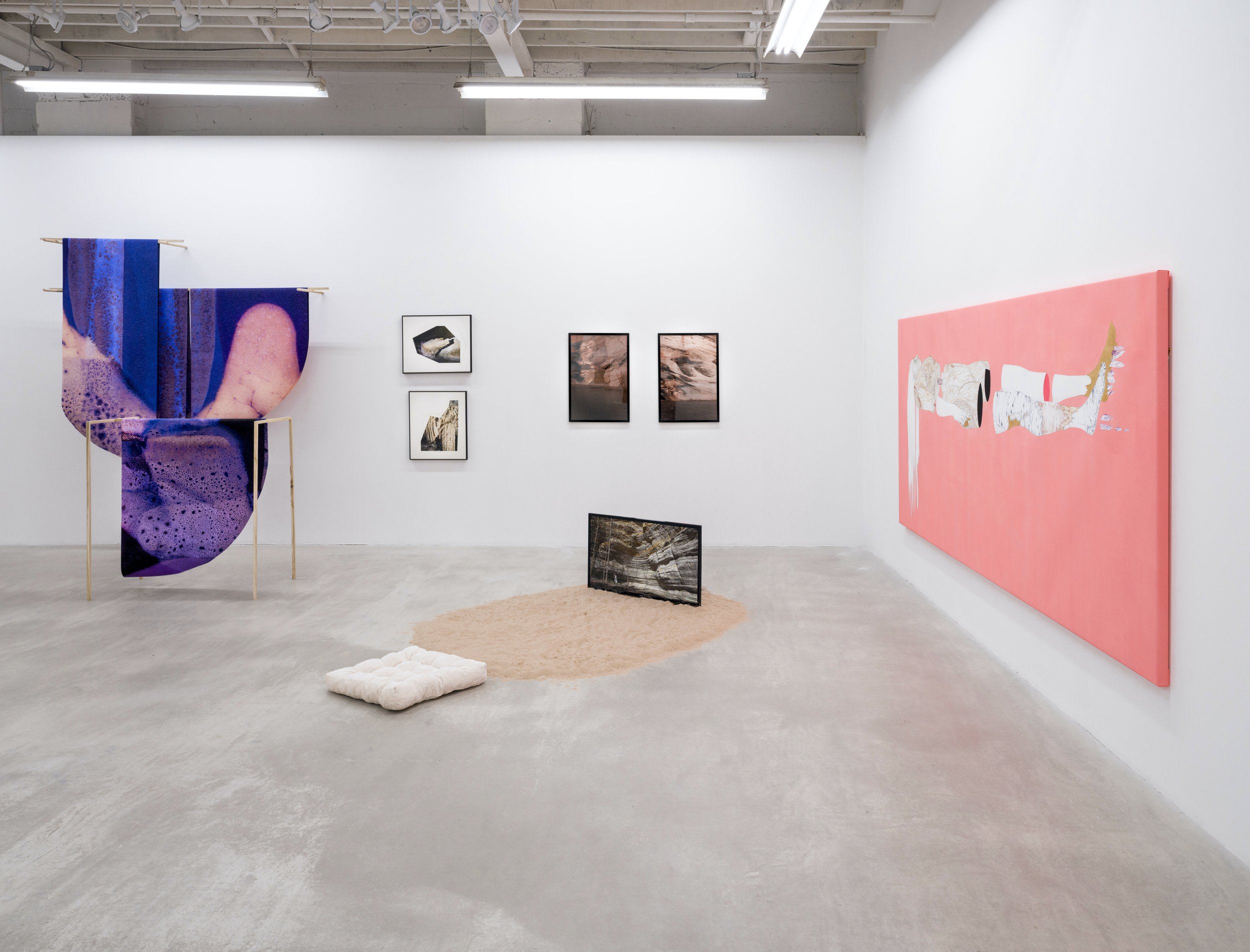21 WADE AVE #2 | TORONTO
eroding territory | curated by Cecilia González Godino
28 MARch - 11 may 2024
a body, a continental jut
a density of times past
an assemblage of other who are you, a being made of beings
linked down the falls’ vertical down the ribbons of water that
narrow and turn helices vanish into the emerald i down who
parents? down waterfall, down rock, down moss-soft crater, down frond
of the giant bromeliad down past the abstract pointillism
of mosquito swarms, down foreign, afar down the streaming roar
down the curtain of lives, the bustle and drip leaf folds, moss
grandparents? i pass them on the way down.
they belong to other families indi-, akan?
i do not know them. portu- chi-?
home
Excerpt from a poem in Magnetic Equator, by Kaie Kellough (2019)
The term “territory” comes from the Latin terra torium or “the land that belongs to someone.” To speak of “territory,” or to approach geopolitical history in “territorial” terms, therefore entails an alleged human right of possession of the land—that has too often granted ownership of its natural resources and its inhabitants to those claiming its “discovery.”
With the notion of territory also came the superficial and artificial delimitation of the natural space, creating the illusion of containment and of borders to respond to imperial needs, and to then articulate a national identity. Colonial mappings emptied the environment of meaning, both delineating its possibilities and disregarding those geological and subaltern elements that exist beyond the superficial and flattening vision that western imperatives imposed on the Earth.
The artists featured in this exhibition dismantle colonial structures of landscape by reclaiming a geological agency that allows them to dive into the sediments and layers of their diasporic identities—to dive into a “terra” with multiple spaces, undercurrents, and temporalities.
The silkscreened maps by Sebastián Maquieira engage with the pictorial vocabulary of cartography while hinting at its silences, echoes, and excesses. By superimposing the symbols and languages of mapping—illustrations of boats, botanical drawings, technological progress, architectural elements…—to the colonial map, he destabilizes its authority to prompt questions about human intervention and human representations of nature. The questioning of western views of nature is also evident in Assaf Evron's layered photographs of the inside of caves. Trimming the mat board that holds them, the artist forces a visual perspective on the cave while insisting on the impossibilities of its representation. Caves are living organisms carved out by water that do not respond to the territorial systems of the surface: rather than linear processes of expansion, they take shape through processes of erosion.
Also reflecting on the ebb and flow of geological formations and human deformations, Farah Salem imbues desert rock landscapes with movement—breaking the illusion of stillness and permanence that often filters their forms of representation. Invoking a deterritorialized existence through ritual, oral history and archival materials, the artist inscribes geological language in her own diasporic and intergenerational history. A similar sense of suspension permeates the work of Marigold Santos, who addresses the perception of fragmentation that often accompanies the diasporic condition and that presents the migrant body as a territorialized surface. Instead, the artist ventures into a psychic territory of shapeshifting and multiplicity that erodes essentialist notions of identity. Mimicking the natural processes of weathering and erosion, Santos’ memory hoodoos conjure up an interlocking relationship between the ritual, the archival, and the geological.
Colonial notions of territory are undoubtedly inhabited by many specters haunting official accounts of history that remain unchanged. And with a lethargic swaying of Atlantic waves, Martha Atienza stirs the fossilized waters of history. The title—a group of coordinates marking a diluted point on the map of the ocean—ironically reveals the impossibility of locating the geological in a static point. In turn, breaking through the lethargy of history with dissonance and juxtaposition, Alberta Whittle injects the atrocious realities of the Middle Passage into the apparent tranquility and innocence of the Atlantic. Once confronted with the complicity of the ocean in absorbing and diluting the violence against Black bodies, the artist allows for a space of regeneration and healing.
If Whittle’s work prompts the question “what sound does the Black Atlantic make?,” the installation by Kara Springer deconstructs the shape of mountains, particularly of Caribbean mountains, through infinite levels of abstraction. Echoing the stories of marronage in Jamaica, where escaped enslaved Africans found refuge in the mountains and in their intricate terrains, the artist rearticulates geological history as one of agency, of emancipatory processes that transcend national frameworks. A movement of similar discordance is staged by Christina Leslie, whose practice forces a material encounter between plantation economies, colonial architectures, colonial forms of representation, and trade products. Printed on cane sugar paper, distorted images of colonialism are here materially sustained by the trafficking and forced labor of enslaved Black bodies.
Also reformulating the landscapes of territory, history, and identity through material investigations, Alexa Kumiko Hatanaka summons the poetic potential of the Japanese traditional handcrafted paper washi. Processed by hand and infused with the spiraloid and patchworked history of the human, animal, and geological bodies that integrate it, the vulnerability of paper becomes a resilient relational materiality. Similarly, Nep Sidhu interrogates the mappings and writings of memory, orchestrating a constellation of possibilities that emerge from the dialogue between the geometric form and the rhythms of nature and history. By gradually reducing the size of calligraphy as the script plunges into the spiral, the artist engages with environmental degradation and a chronic detachment from nature.
In eroding territory, notions of belonging that presuppose a physical connection to the land are proven to be impossible in the face of the organic, symbolic, and historical vestiges of colonial expansion, chattel slavery, imperial extraction, land dispossession, and forced migration.
This exhibition investigates how migratory experiences—either forced or voluntary—and diasporic existences break down categories of national identity and of national territory that have served as modern forms of control. Human movement, and the multiple forms of violence that have determined its routes over the centuries, also enabled intangible forms of connection and below-the-surface entanglements that escape western accounts of history and of identity.
– Cecilia González Godino
Cecilia González Godino is a curator, writer, and researcher engaging with contemporary art from transoceanic, diasporic, and archipelagic frameworks. She is a PhD candidate in Visual Art and Caribbean Studies at the University of Pennsylvania, holds an MA from New York University, and is currently the Marjorie Susman Curatorial Fellow at the Museum of Contemporary Art Chicago. She has published her writing in Artelogie and Sixty Inches from Center, among others, and is the curator of Unsovereign Elements (UPenn, Philadelphia, 2023) and Trade Windings (MCA Chicago, 2024). She is based between Chicago and Philadelphia.
Alberta Whittle is an artist, researcher, and curator. She was awarded a Turner Bursary, the Frieze Artist Award, and a Henry Moore Foundation Artist Award in 2020. Alberta is a PhD candidate at Edinburgh College of Art and is a Research Associate at The University of Johannesburg. She was a RAW Academie Fellow at RAW Material in Dakar in 2018 and is the Margaret Tait Award winner for 2018/9. Her creative practice is motivated by the desire to manifest self-compassion and collective care as key methods in battling anti-blackness. She choreographs interactive installations, using film, sculpture, and performance as site-specific artworks in public and private spaces.
Alberta has exhibited and performed in various solo and group shows, including at Gothenburg Biennale (2021), Remai Modern (2021), Liverpool Biennale (2021), The British Art Show – Aberdeen (2021), Glasgow International (2021), GoMA, Glasgow (2019), Pig Rock Bothy at the National Galleries of Scotland, Edinburgh (2019), 13th Havana Biennale, Cuba (2019), National Art Gallery of the Bahamas (2018), the Apartheid Museum, Johannesburg (2017), at the Johannesburg Pavilion at the 56th Venice Biennale, Venice (2015), and BOZAR, Brussels (2014), amongst others.
Her work has been acquired for the UK National Collections, The Scottish National Gallery Collections, Glasgow Museums Collections and The Contemporary Art Research Collection at Edinburgh College of Art amongst other private collections.
Alexa Kumiko Hatanaka is a Japanese-Canadian artist based in Toronto. Her practice brings together historical craft technologies of her heritage including ink, natural dye, printmaking and papermaking. Her work is experience based and includes long-term community-engaged projects with collaborators in the high Arctic as well as recent collaborative performances that integrate and reinterpret kamiko, garments sewn out of washi, Japanese paper. Her work carries forward the beauty and possibilities of environmentally sustainable traditions into the future. Her approach to wearable sculpture removes the boundaries between craft, fashion and art. Hatanaka’s intentional choice of materiality supports the concepts embedded in her work which includes interconnectedness and impacts of globalization on communities integrally grounded in specific lands and collapsing time to layer ancestry and past versions of self. Hatanaka has exhibited her work at the National Gallery of Canada (Ottawa, CA), Art Gallery of Ontario (Toronto, CA), The British Museum (London, UK), Toronto Biennial of Art (Toronto, CA) the Guanlan International Printmaking Base (Shenzhen, China), Nikkei National Museum (Burnaby, CA) and Harper’s (New York, USA).
Assaf Evron is an artist and a photographer based in Chicago. His work investigates the nature of vision and the ways in which it reflects in socially constructed structures, where he applies photographic thinking in various two and three-dimensional media. Looking at moments along the histories of modernism Evron questions the construction of individual and collective identities, immigration (of people, ideas, images) and the representations of democracy. His work has been exhibited in galleries and museums internationally. Evron holds an MA from The Cohn Institute as well as an MFA from the School of the Art Institute of Chicago (SAIC), where he currently teaches. In conjunction with his exhibition at Patel Brown he is presenting a special architectural intervention project at the Mies van der Rohe-designed Edith Farnsworth House in Plano Illinois.
Christina Leslie is a lens-based artist from Toronto, who earned a B.F.A. from OCADU in 2006 and an M.F.A. from the Savannah College of Art and Design in 2022. Her art practice focuses on themes that delve into decolonization, identity, immigration, marginalization, history, memory, race, and her West Indian background, which she explores via various experimental photography methods and text. Her work has appeared in prominent art journals such as MURZE art magazine, Divide Art Magazine, Art Seen Magazine, CAP Art Magazine, and Pitch Magazine. Her most recent photographic series "Sugar Coat" received praise from Ain't Bad Magazine, Featureshoot.com, and PetaPixel.com, and was recently exhibited at BAND Gallery with support from the Honda Canada Foundation (2023), RIT City Art Space in Rochester, NY as part of the Homecoming Photo Biennial (2023) and at the Exposure Festival in Calgary (2024) and an upcoming solo exhibition at the Robert McLaughlin Gallery in November 2024. Leslie's photographs have been exhibited at various institutions across the globe, including The GAMU in Prague, Oakland University in Michigan, The Royal Ontario Museum, Canada's Pier 21, The Art Gallery of Windsor, The Caribbean Art Fair in Jamaica, The McMaster Museum of Art, Paris Photo art fair and the Museum of Contemporary Art (MOCA) in Toronto. Her "Morant Bay" series was featured prominently at the Scotiabank Contact Photography Festival and the Capture Festival in Vancouver, where three photos from the series were converted into billboards. She is the 2024 curator of the exhibition SUMMA which is a 4th year undergraduate show at the McMaster Museum of Art. Her "EveryTING Irie" series is part of Dr. Kenneth Montague's "The Wedge Collection" and is in the permanent collection of the Art Gallery of Ontario.
Farah Salem (b. Kuwait) is a Chicago-based multidisciplinary artist and art therapist. In her studio practice, she merges present experiences of human and geologic happenings, while looking at themes of access, agency, power, and the invisibly visible. She investigates the distortion of reality and perception, questioning the potential erasure of socio-cultural conditioning that influences and distorts our shared realities. She holds an MA in Art Therapy and Counseling from the School of the Art Institute of Chicago and a BA in Visual Communications. Farah’s work has been featured at Museum of Contemporary Art (Chicago), Museum of Contemporary Photography (Chicago), American University Museum Katzen Art Center (Washington DC), United Photo Industries (New York), Mana Contemporary (Chicago), Centro Cultural De Santa Cruz (Bolivia), Paris Contemporary Art Fair, Sharjah Art Foundation (UAE), and Contemporary Art Platform (Kuwait). Farah was named the Laureate Winner of the Women’s Photographers Award 2017 and has been published by the Kuwait National Council for Culture, Arts and Letters for her photography book titled In-Between the Skyline of Kuwait City. She has participated in artist residencies including ACRE, Hyde Park Art Center, Hatch at Chicago Artist Coalition, Crossway Foundation, and Per|Form.
Born in Barbados, Kara Springer lives and works in Toronto and New York. Her practice is particularly concerned with armature – the underlying structure that holds the flesh of a body in place. She uses photography, sculpture, and site-specific interventions to confront and engage with architecture, urban infrastructure, and systems of institutional and political power. Springer holds degrees from the University of Toronto, OCAD University, ENSCI les Ateliers in Paris, and the Tyler School of Art, Temple University. Her work has been exhibited at the Museum of Contemporary Art (Toronto), Artists Space (New York), the Institute of Contemporary Art (Philadelphia), the National Gallery of the Bahamas, the National Gallery of Jamaica, and the Frankfurt Museum of Applied Arts. She is an alum of the Independent Study Program at the Whitney Museum of American Art and recently held a 2 year fellowship with the Core Program at the Museum of Fine Arts Houston.
Marigold Santos was born in the Philippines, and immigrated with her family to Canada in 1988. She pursues an inter-disciplinary art practice that examines diasporic lived experience and storytelling, presented within the otherworldly. Her paintings, drawings, sculptures, and tattoo work explores self-hood and identity that embraces multiplicity, hybridity, and fragmentation, while considering the fragmented yet empowering relationships to heritage. She holds a BFA from the University of Calgary, and an MFA from Concordia University. As a recipient of grants from the Canada Council for the Arts, the Alberta Foundation for the Arts, and the Conseil des Arts et des Lettres du Québec, she continues to exhibit widely across Canada. Her recent solo exhibitions include SURFACE TETHER at the Art Gallery of Alberta (2019) MALAGINTO at Montréal, Arts Interculturels (MAI) and the Dunlop Art Gallery in Regina (2019), hiwa-hiwalay Patel Brown in Toronto (2020), and binhi at buhol Jarvis Hall Gallery (2021). She was selected to be a collaborating artist with Yoko Ono’s Water Event piece in the exhibition Growing Freedom (2019), and exhibited her works in Relations – Diaspora and Painting (2020), both at the Fondation Phi in Montreal, and at the Esker Foundation (2021). She maintains an active studio practice and resides in Treaty 7 Territory, in Mohkinstsis/Calgary.
Born to a Dutch mother and Filipino father, Martha Atienza (b. 1981, Manila, Philippines; lives and works in Bantayan Island, Philippines) has moved between the Netherlands and the Philippines throughout her life. Constantly oscillating between these two cultures has had a profound influence on Atienza's focus as an artist. Atienza's practice explores installation and video as a way of documenting and questioning issues around environment, community and development. Her work is mostly constructed in video, of an almost sociological nature, that studies her direct environment. Often utilizing technology in the form of mechanical systems, Atienza explores the immersive capacity of installation in generating critical discourse. Her work tends to be collaborative in nature, working with people from different backgrounds and expertise as well as residents of Bantayan Island, where her family is from, whose narratives are intricately woven into issues such as environmental change, displacement, cultural loss, governance and socio- economic disparities. Since graduating with a Bachelor in Fine Arts from the Academy of Visual Arts and Design in the Netherlands, Atienza has exhibited internationally at various art spaces, galleries, and video festivals. In 2017, Atienza won the Baloise Art Prize in Art Basel (Switzerland) for her work, Our Islands 11°16'58.4_N 123°45'07.0_E. In 2016, she was one of the five shortlisted artists for the Benesse Art Prize (Japan) in the Singapore Biennale. In 2015, Atienza was awarded the Thirteen Artists Awards by the Cultural Center of the Philippines. In 2016 and 2012, she won the prestigious Ateneo Art Award with studio residency grants in Liverpool, Melbourne, New York and Singapore.
Nep Sidhu is an interdisciplinary practitioner who works through the metaphysics of form and spatial rhythm within the context of community and self-expression. Through material investigations of textile, sculpture, painting, video, and sound, Sidhu's work seeks symbolic pathways that help to realize the formlessness of the divine through endless possibility and search. Sidhu participated in exhibitions with the Nagoya City Museum, Japan Aichi Triennale; Museum of Contemporary Art, Toronto; Esker Foundation, Calgary; Heard Museum, Phoenix; Art Gallery of York University, Toronto; Aga Khan Museum, Toronto; and The Frye Museum of Art, Seattle; Glasgow International, Scotland. Most recently Nep Sidhu was featured in his first solo U.S. museum exhibition at the Museum of Contemporary Art Detroit.
Sebastian Maquieira (b.1978 Santiago, Chile) is interested in exploring the different insights that certain objects and materials that come from within our cultural surroundings can offer. The artist manipulates them to produce new artifacts where the sum of the parts is in a tense intersection, and their aesthetic qualities could be activated as much as their functions and signals that inhabit and operate within our conscience. Around 2018 Maquieira started working with found antique maps and using silk screening in order to emphasize his own pictorial vocabulary. From here, Sebastian expanded on his process by working with old antique books, dictionaries and encyclopedias. Maquieira graduated from Finis Terrae University with a degree in Fine Arts in 2003. That same year he was awarded a scholarship to intern in the studio of Eugenio Téllez for six months in NYC. Maquieira has exhibited extensively in his native Chile and also in Ecuador, Buenos Aires and London, UK.
